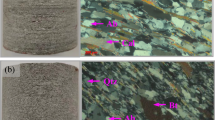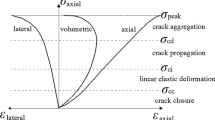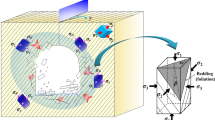Abstract
In this study, a failure criterion is proposed for describing the strength variation of foliated rocks that possess inherently anisotropic properties due to the existence of macro weak planes (MWPs). These rocks are typically characterized by the clustering and directional arrangement of needle-flaky minerals, a quasi-interlayered structure composed of weak and strong layers, and a directional arrangement of microcracks. The compressive failure mode of foliated rocks subjected to confining pressure is heavily dependent on the loading direction, which can be divided into two types within a certain range of confining pressures: shear-slip failure along the MWP and macro shear failure oblique to the MWP. From the perspective of the failure mechanism related to rock fabric and macrofailure characteristics, the linear failure criteria available for the two modes are proposed based on fracture mechanics theory, the Mohr–Coulomb criterion and the maximum axial strain criterion. The criteria involve 6 parameters that can be simply determined by a small amount of test data. Among them, the friction coefficient f is closely related to the loading direction corresponding to the minimum compressive strength, and the transversely isotropic parameter n controls the variation form of anisotropic strength with the loading direction. The predicted values of several kinds of exemplary foliated rocks agree well with their measured compressive strengths depending on the confining pressure and loading direction, suggesting a high prediction accuracy for the new criterion. The analysis reveals that the new criterion is suitable for describing the failure of brittle foliated rocks within a certain range of confining pressures.











Similar content being viewed by others
References
Asadi M, Bagheripour MH (2015) Modified criteria for sliding and non-sliding failure of anisotropic jointed rocks. Int J Rock Mech Min Sci 73:95–101
Attewell PB, Sandford MR (1974) Intrinsic shear strength of a brittle, anisotropic rock—I. Int J Rock Mech Min Sci Geomech Abst 11:423–430
Attewell PB, Taylor RK (1969) A microtextural interpretation of a welsh slate. Int J Rock Mech Min Sci Geomech Abstr 6(5):425–438
Bagheripour MH, Rahgozar R, Pashnesaz H, Malekinejad M (2011) A complement to Hoek-Brown failure criterion for strength prediction in anisotropic rock. Geomech Eng 3(1):61–81
Barton N (1976) The shear strength of rock and rock joints. Int J Rock Mech Min Sci Geomech Abstr 13(9):255–279
Behrestaghi M, Rao KS, Ramamurthy T (1996) Engineering geological and geotechnical responses of schistose rocks from dam project areas in India. Eng Geol 44(1):183–201
Bobet A, Einstein HH (1998) Fracture coalescence in rock-type material under uniaxial and biaxial compressions. Int J Rock Mech Min Sci 35(7):863–888
Boehler JP (1987) Anisotropic linear elasticity. Springer, Vienna
Chen LL, Liu C, Zhao WC, Liu LC (2018) An isogeometric approach of two dimensional acoustic design sensitivity analysis and topology optimization analysis for absorbing material distribution. Comput Methods Appl Mech Eng 336:507–532
Cho JW, Kim H, Jeon S, Min KB (2012) Deformation and strength anisotropy of Asan gneiss, Boryeong shale, and Yeoncheon schist. Int J Rock Mech Min Sci 50:158–169
Deng HF, Wang W, Li JL, Zhang YC, Zhang XJ (2018) Experimental study on anisotropic mechanical properties of layered sandstone. Chin J Rock Mech Eng 37(1):112–120
Donath FA (1964) Strength variation and deformational behavior in anisotropic rock. In: Judd WR (ed) State of stress in the Earth’s crust. Elsevier, New York, pp 281–297
Duveau G, Shao JF (1998) A modified single discontinuity theory for the failure of highly stratified rocks. Int J Rock Mech Min Sci 35(6):807–813
Duveau G, Shao JF, Henry JP (1998) Assessment of some failure criteria for strongly anisotropic geomaterials. Mech Cohes Frict Mater Int J Exp Model Comput Mater Struct 3(1):1–26
Fereidooni D, Khanlari GR, Heidari M, Sepahigero AA, Kolahi AP (2016) Assessment of inherent anisotropy and confining pressure influences on mechanical behavior of anisotropic foliated rocks under triaxial compression. Rock Mech Rock Eng 49(6):2155–2163
Hoek E, Brown ET (1980) Empirical strength criterion for rock masses. J Geotech Eng Div 106(15715):1013–1035
Jaeger JC (1960) Shear failure of anisotropic rocks. Geol Mag 97(1):65–72
Kwasniewski MA (1993) Mechanical behavior of anisotropic rocks. In: Hudson JA (ed) Comprehensive rock engineering, vol 1. Pergamon, Oxford, pp 285–312
Li LQ, Zhang CS, Wang W (2018) A modified Hoek-Brown failure criterion for anisotropic rock mass. Chin J Rock Mech Eng 37(Supp. 1):3239–3246
Li SY (2010) Introduction of rock fracture mechanics. University of Science & Technology China press, Hefei
Martin CD (1997) The effect of cohesion loss and stress path on brittle rock strength. Can Geotech J 34(5):698–725
Mclamore R, Gray KE (1967) The mechanical behavior of anisotropic sedimentary rocks. J Eng Ind 89(1):62–73
Nasseri MH, Rao KS, Ramamurthy T (1997) Failure mechanism in schistose rocks. Int J Rock Mech Min Sci 34(3–4):219–234
Nasseri MH, Rao KS, Ramamurthy T (2003) Transversely isotropic strength and deformational behavior of Himalayan schists. Int J Rock Mech Min Sci 40:3–23
Niandou H, Shao JF, Henry JP, Fourmaintraux D (1997) Laboratory investigation of the mechanical behaviour of Tournemire shale. Int J Rock Mech Min Sci 34(1):3–16
Ohtsu M, Isoda T, Tomoda Y (2007) Acoustic emission techniques standardized for concrete structures. J Acoust Emiss 25:21–32
Pariseau WG (1968) Plasticity theory for anisotropic rocks and soils. In: The 10th U.S. Symposium on Rock Mechanics, Austin, Texas
Ramamurthy T (1993) Strength and modulus responses of anisotropic rocks. In: Hudson JA (ed) Comprehensive rock engineering, vol 1. Pergamon, Oxford, pp 313–329
Ramamurthy T (2004) A geo-engineering classification for rocks and rock masses. Int J Rock Mech Min Sci 41(1):89–101
Ramamurthy T, Rao GV, Singh J (1988) A strength criterion for anisotropic rocks. In: Proc. 5th Australia-New Zealand Conference on Geomechanics, Sydney
Ramamurthy T, Rao GV, Singh J (1993) Engineering behaviour of phyllites. Eng Geol 33(3):209–225
Rawling GC, Baud P, Tengfong W (2002) Dilatancy, brittle strength, and anisotropy of foliated rocks: experimental deformation and micromechanical modeling. J Geophys Res 107(B10):2234–2247
Saeidi O, Rasouli V, Vaneghi RG, Gholami R, Torabi SR (2014) A modified failure criterion for transversely isotropic rocks. Geosci Front 5(2):215–225
Sagong M, Bobet A (2002) Coalescence of multiple flaws in a rock-model material in uniaxial compression. Int J Rock Mech Min Sci 39(2):229–241
Saroglou H, Tsiambaos G (2008) A modified Hoek-Brown failure criterion for anisotropic intact rock. Int J Rock Mech Min Sci 45(2):223–234
Shi XC, Yang X, Meng YF, Li G (2016) Modified Hoek-Brown failure criterion for anisotropic rocks. Environ Earth Sci 75(11):1–11
Singh J, Ramamurthy T, Rao GV (1989) Strength anisotropies in rocks. Indian Geotech J 19(2):147–166
Singh M, Samadhiya NK, Kumar A, Kumar V, Singh B (2015) A nonlinear criterion for triaxial strength of inherently anisotropic rocks. Rock Mech Rock Eng 48(4):1387–1405
Tien YM, Kuo MC (2001) A failure criterion for transversely isotropic rocks. Int J Rock Mech Min Sci 38:399–412
Tsai SW, Wu EM (1971) A general theory of strength of anisotropic materials. J Compos Mater 5(1):58–80
Walsh JB, Brace WF (1964) A fracture criterion for brittle anisotropic rock. J Geophys Res 69(16):3449–3456
Wang CL, Hou XL, Li HT, Zhang SJ, Tao ZG (2019) Experimental investigation on dynamic evolution characteristics of micro-cracks for sandstone samples under uniaxial compression. Bull Disaster Prevent Res Inst Kyoto Univ 41(11):2120–2125
Wu YS, Tan ZS, Yu XB, Yu Y, Li L, Guo XL (2001) Comparative tests on strength and deformation of phyllite of northern tunnels of Longmen Mountains. Chin J Geotech Eng 38:399–412
Zhang XP, Wong L, Wang SJ et al (2011) Engineering properties of quartz mica schist. Eng Geol 121(3–4):135–149
Zhou Y, Su SR, Li P, Ma HS, Zhang XD (2019) Microstructure and mechanical properties of broken phyllite. J Jilin Univ (earth Sci Ed) 49(2):504–513
Yin XM, Yan EC, Wang LN, Liu LC, Feng B, Wang PZ (2020) Anisotropy of quartz mica schist based on quantitative extraction of fabric information. Bull Eng Geol Env 79(5):2439–2456
Yin XM, Zhang X, Lei YJ, Wang LN (2021) Response characteristics and mechanism of the strength and energy of schist to the schistosity orientation and water. Bull Eng Geol Env 80(9):7029–7049
Funding
This research is financially supported by the Natural Science Foundation of China (Grant no. 41807240) and the Nanhu Scholars Program of Xinyang Normal University. The author gratefully acknowledges the financial support provided by them.
Author information
Authors and Affiliations
Corresponding author
Rights and permissions
About this article
Cite this article
Yin, X., Zhang, Y., Lei, Y. et al. Linear failure criterion for estimating the compressive strength of brittle foliated rocks in response to the loading direction. Bull Eng Geol Environ 81, 189 (2022). https://doi.org/10.1007/s10064-022-02681-4
Received:
Accepted:
Published:
DOI: https://doi.org/10.1007/s10064-022-02681-4




